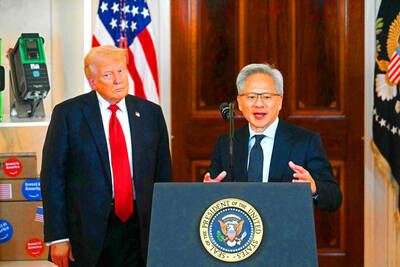South Korean workers’ wages are rising faster than those of regional rivals and the power of the nation’s sprawling family-run conglomerates, or chaebols, remains unchecked, highlighting a lack of serious economic reform. Yet, manufacturing exports are booming.
Taiwan’s labor costs are cheap and its effective exchange rate far more competitive, yet overseas shipments have been flailing.
The divergence, set out in an Oxford Economics report, deepens given the similar export mixes of the two developed economies — indeed, an indicator of trade similarity stands at 0.67, high given that 1.0 represents an identical mix.
The two also essentially ship goods to the same markets. Yet, South Korean export volume surged 5.3 percent yearly from 2010 to last year, compared with just 1.4 percent for Taiwan.
The difference is the extent to which South Korean companies have moved up the value chain and developed global brands, especially in the electronics and auto manufacturing industries, Oxford Economics senior economist Oliver Salmon said.
“Taiwan hosts many technologically sophisticated companies, especially in semiconductors and electronics, but few true global brands,” Salmon said, contrasting Foxconn Technology Group (富士康科技集團) with Samsung Electronics Co. “In part, this is because Taiwan is handicapped by its relatively low profile and uncertain status.”
South Korea has also forged ahead with free-trade accords.
Oxford Economics said that since signing a deal with the US, average tariffs have fallen from 3.8 percent in 2011 to 0.4 percent in 2015.
That underpinned growth in merchandise exports to the US of 3.4 percent per year in nominal US dollar terms through last year. In contrast, Taiwanese exports over the same period fell 1.7 percent a year.
Taiwan was among the losers in Oxford Economics’ survey of Asian economies’ trading performances since the 2008 global financial crisis.
Most in this category were relatively developed — Hong Kong, Japan, Thailand and Singapore — and lost manufacturing to regional competitors as their costs climbed without offsetting gains in innovation or productivity.
Singapore was particularly hard hit. Its electronics exports have slumped by one-third since 2010. Part of the explanation is stricter controls on migrant workers since 2010 that tightened the labor market and resulted in nominal wages in manufacturing surging 20 percent in US dollar terms through 2015.
However, while wages rose, productivity stagnated, resulting in unit labor costs climbing faster than in any other developed Asian economy in the survey.
Meanwhile, Malaysia and the Philippines have picked up the slack, spurred by cheaper production and increasing foreign investment.
India, in turn, has benefited from its cheap labor and a low base of comparison to work off.
Thailand has also struggled to adapt to increasing competition from regional rivals, particularly in labor-intensive manufacturing, with the emergence of the “CMLV [Cambodia, Myanmar, Laos and Vietnam] group of economies in ASEAN,” the survey said.
Oxford Economics predicted that world trade growth will accelerate to 3.5 percent this year and to 4 percent by 2020, which is still below the long-term average of almost 5 percent.
As a result, competition for market share “will be fierce,” it said, adding that medium-term forecasts of winners and losers in Asia should broadly mirror the recent past.
“The old adage may say that ‘past performance is no indicator of future results,’ but in this instance, it might be,” Salmon said.

Taiwan Semiconductor Manufacturing Co (TSMC, 台積電) last week recorded an increase in the number of shareholders to the highest in almost eight months, despite its share price falling 3.38 percent from the previous week, Taiwan Stock Exchange data released on Saturday showed. As of Friday, TSMC had 1.88 million shareholders, the most since the week of April 25 and an increase of 31,870 from the previous week, the data showed. The number of shareholders jumped despite a drop of NT$50 (US$1.59), or 3.38 percent, in TSMC’s share price from a week earlier to NT$1,430, as investors took profits from their earlier gains

AI TALENT: No financial details were released about the deal, in which top Groq executives, including its CEO, would join Nvidia to help advance the technology Nvidia Corp has agreed to a licensing deal with artificial intelligence (AI) start-up Groq, furthering its investments in companies connected to the AI boom and gaining the right to add a new type of technology to its products. The world’s largest publicly traded company has paid for the right to use Groq’s technology and is to integrate its chip design into future products. Some of the start-up’s executives are leaving to join Nvidia to help with that effort, the companies said. Groq would continue as an independent company with a new chief executive, it said on Wednesday in a post on its Web

CHINA RIVAL: The chips are positioned to compete with Nvidia’s Hopper and Blackwell products and would enable clusters connecting more than 100,000 chips Moore Threads Technology Co (摩爾線程) introduced a new generation of chips aimed at reducing artificial intelligence (AI) developers’ dependence on Nvidia Corp’s hardware, just weeks after pulling off one of the most successful Chinese initial public offerings (IPOs) in years. “These products will significantly enhance world-class computing speed and capabilities that all developers aspire to,” Moore Threads CEO Zhang Jianzhong (張建中), a former Nvidia executive, said on Saturday at a company event in Beijing. “We hope they can meet the needs of more developers in China so that you no longer need to wait for advanced foreign products.” Chinese chipmakers are in

POLICY REVERSAL: The decision to allow sales of Nvidia’s H200 chips to China came after years of tightening controls and has drawn objections among some Republicans US House Republicans are calling for arms-sale-style congressional oversight of artificial intelligence (AI) chip exports as US President Donald Trump’s administration moves to approve licenses for Nvidia Corp to ship its H200 processor to China. US Representative Brian Mast, the Republican chairman of the US House Committee on Foreign Affairs, which oversees export controls, on Friday introduced a bill dubbed the AI Overwatch Act that would require the US Congress to be notified of AI chips sales to adversaries. Any processors equal to or higher in capabilities than Nvidia’s H20 would be subject to oversight, the draft bill says. Lawmakers would have